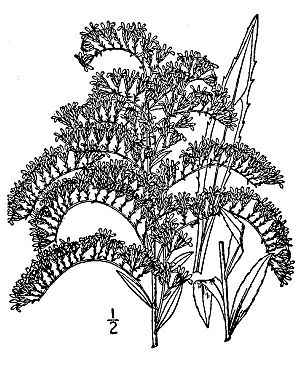Short's goldenrod facts for kids
Quick facts for kids Short's goldenrod |
|
|---|---|
 |
|
| 1913 illustration | |
| Conservation status | |
| Scientific classification | |
| Genus: |
Solidago
|
| Species: |
shortii
|
| Synonyms | |
|
|
Solidago shortii, also known as Short's goldenrod, is a type of goldenrod plant. It belongs to the sunflower family. This special plant is only found in a few places. Most of them grow around the Blue Licks Battlefield State Park area in Kentucky. Some are also found in the Harrison-Crawford State Forest in Indiana.
Short's goldenrod was added to the list of endangered species on September 5, 1985. This means it was in danger of disappearing forever. On February 29, 2000, it was given a global rank of G1. This means it is critically endangered, which is the highest level of risk.
Contents
What Short's Goldenrod Looks Like
Short's goldenrod is a perennial plant, meaning it lives for many years. It grows from special underground stems called rhizomes. These rhizomes help the plant spread.
This plant can grow to be about 60–75 cm (1.97–2.46 ft) tall. Its leaves are usually 5–10 cm (2.0–3.9 in) long and 5–12 mm (0.20–0.47 in) wide. Short's goldenrod produces bright yellow flowers. These flowers bloom from the middle of August until November. After flowering, the plant releases its seeds from late September to late November.
How Short's Goldenrod Reproduces
Short's goldenrod can make new plants in two ways:
- Vegetative reproduction: This is when new plants grow from the underground rhizomes. It's like a clone of the parent plant.
- Sexual reproduction: This happens when seeds are produced.
These plants cannot pollinate themselves. This means they need help from other plants to make seeds. The goldenrod soldier beetle is very important for moving pollen between different Short's goldenrod plants. Long ago, bison might have also helped spread the seeds. Unlike some other goldenrod types, Short's goldenrod seeds do not seem to spread easily by wind.
Short's goldenrod is different from the more common goldenrod called Solidago altissima. Short's goldenrod is usually shorter and spreads more slowly, whether by rhizomes or seeds. However, once it starts growing in a place, Short's goldenrod can handle drought better. Some groups of these plants have been growing in the same spots for over 50 years!
Where Short's Goldenrod Lives
Short's goldenrod grows best in shallow, clay soils. It likes places with lots of sun or a little bit of shade. You can often find it in pastures, on rock ledges, in areas with limestone, and in open parts of woods or forests. These open areas can be natural, like after a fire, or made by humans, like power line paths.
For the plant to grow well, there should be more than 300 healthy plants. They need to be spread out over 10 acres or more. It also helps if there is other plant life around for at least 1.6 km (0.99 mi) to protect them.
Sadly, in the 1970s, a lot of good habitat for the plant was destroyed. This happened when a new campground was built at Blue Licks Battlefield State Park. To help protect the plant, a special area was created. On December 16, 1981, a piece of land about 6 ha (15 acres) was given to the Kentucky State Nature Preserves Commission. This land became the Blue Licks State Nature Preserve. Its main goal was to save Short's goldenrod. More land was added later, making the preserve 21 ha (53 acres) in total. Today, the preserve even hosts the Short's Goldenrod Festival. All the money raised from the festival helps efforts to protect this rare plant.
History of Short's Goldenrod
Short's goldenrod was first officially described by two scientists, John Torrey and Samuel Frederick Gray, in 1842. It was named after Dr. Charles Wilkins Short from Louisville, Kentucky. He was the one who found it growing on a limestone rock island in the Falls of the Ohio in 1840.
The plant was last seen at that original spot in 1860. It might have kept growing there if the island hadn't been changed. In the early 1900s, the McAlpine Locks and Dam was built on the falls, which changed the island a lot.
People thought the species was gone forever until 1939. That's when an ecologist named E. Lucy Braun found a group of Short's goldenrod plants near Blue Lick Springs in Kentucky. Later that year, many more groups of the plant were reported in the area. However, only three of those groups still exist today.
In 1995, scientists tried to bring the plant back to Falls of the Ohio State Park. They planted seven clumps of the goldenrod. But sadly, floods wiped out those plants within a year. Six years later, three of those same scientists found a wild group of the plant. This happened while they were studying plants in the Blue River area of Indiana. Before this, there were only five known natural groups of the plant. All of them were in Kentucky, near the border of Robertson, Nicholas, and Fleming counties. They were all within 2-mile (3.2 km) of Blue Licks Battlefield State Park. In 1989, there were about 73,620 stems of the plant counted above ground.


